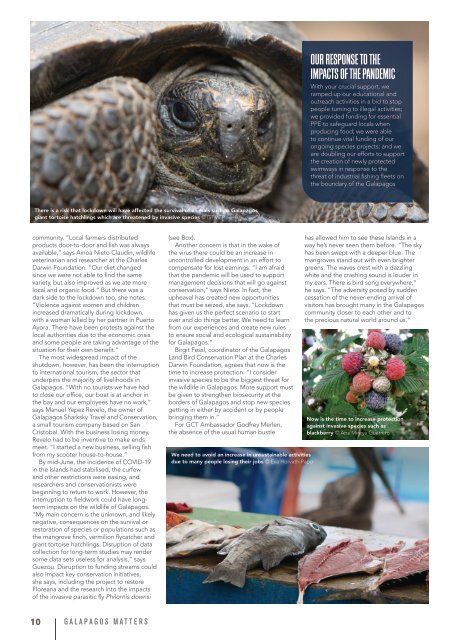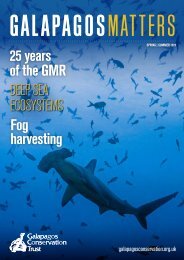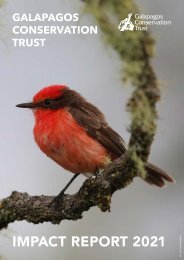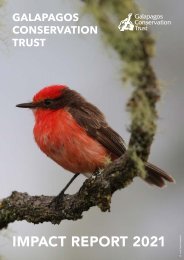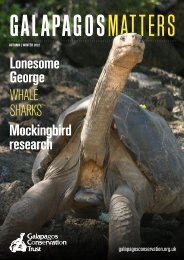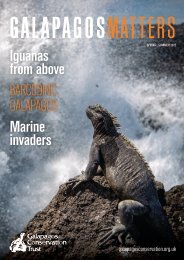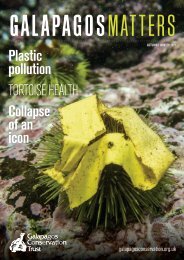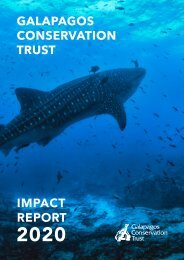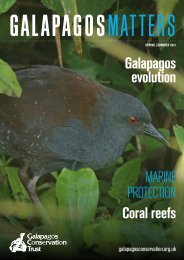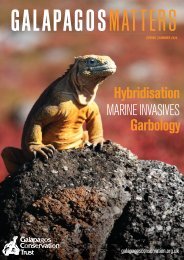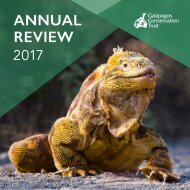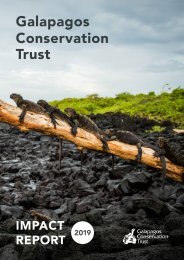You also want an ePaper? Increase the reach of your titles
YUMPU automatically turns print PDFs into web optimized ePapers that Google loves.
OUR RESPONSE TO THE<br />
IMPACTS OF THE PANDEMIC<br />
With your crucial support, we<br />
ramped up our educational and<br />
outreach activities in a bid to stop<br />
people turning to illegal activities;<br />
we provided funding for essential<br />
PPE to safeguard locals when<br />
producing food; we were able<br />
to continue vital funding of our<br />
ongoing species projects; and we<br />
are doubling our efforts to support<br />
the creation of newly protected<br />
swimways in response to the<br />
threat of industrial fishing fleets on<br />
the boundary of the <strong>Galapagos</strong><br />
There is a risk that lockdown will have affected the survival of animals such as <strong>Galapagos</strong><br />
giant tortoise hatchlings which are threatened by invasive species © GTMEP<br />
community. “Local farmers distributed<br />
products door-to-door and fish was always<br />
available,” says Ainoa Nieto Claudin, wildlife<br />
veterinarian and researcher at the Charles<br />
Darwin Foundation. “Our diet changed<br />
since we were not able to find the same<br />
variety, but also improved as we ate more<br />
local and organic food.” But there was a<br />
dark side to the lockdown too, she notes.<br />
“Violence against women and children<br />
increased dramatically during lockdown,<br />
with a woman killed by her partner in Puerto<br />
Ayora. There have been protests against the<br />
local authorities due to the economic crisis<br />
and some people are taking advantage of the<br />
situation for their own benefit.”<br />
The most widespread impact of the<br />
shutdown, however, has been the interruption<br />
to international tourism, the sector that<br />
underpins the majority of livelihoods in<br />
<strong>Galapagos</strong>. “With no tourists we have had<br />
to close our office, our boat is at anchor in<br />
the bay and our employees have no work,”<br />
says Manuel Yepez Revelo, the owner of<br />
<strong>Galapagos</strong> Sharksky Travel and <strong>Conservation</strong>,<br />
a small tourism company based on San<br />
Cristobal. With the business losing money,<br />
Revelo had to be inventive to make ends<br />
meet. “I started a new business, selling fish<br />
from my scooter house-to-house.”<br />
By mid-June, the incidence of COVID-19<br />
in the Islands had stabilised, the curfew<br />
and other restrictions were easing, and<br />
researchers and conservationists were<br />
beginning to return to work. However, the<br />
interruption to fieldwork could have longterm<br />
impacts on the wildlife of <strong>Galapagos</strong>.<br />
“My main concern is the unknown, and likely<br />
negative, consequences on the survival or<br />
restoration of species or populations such as<br />
the mangrove finch, vermilion flycatcher and<br />
giant tortoise hatchlings. Disruption of data<br />
collection for long-term studies may render<br />
some data sets useless for analysis,” says<br />
Guezou. Disruption to funding streams could<br />
also impact key conservation initiatives,<br />
she says, including the project to restore<br />
Floreana and the research into the impacts<br />
of the invasive parasitic fly Philornis downsi<br />
(see Box).<br />
Another concern is that in the wake of<br />
the virus there could be an increase in<br />
uncontrolled development in an effort to<br />
compensate for lost earnings. “I am afraid<br />
that the pandemic will be used to support<br />
management decisions that will go against<br />
conservation,” says Nieto. In fact, the<br />
upheaval has created new opportunities<br />
that must be seized, she says. “Lockdown<br />
has given us the perfect scenario to start<br />
over and do things better. We need to learn<br />
from our experiences and create new rules<br />
to ensure social and ecological sustainability<br />
for <strong>Galapagos</strong>.”<br />
Birgit Fessl, coordinator of the <strong>Galapagos</strong><br />
Land Bird <strong>Conservation</strong> Plan at the Charles<br />
Darwin Foundation, agrees that now is the<br />
time to increase protection. “I consider<br />
invasive species to be the biggest threat for<br />
the wildlife in <strong>Galapagos</strong>. More support must<br />
be given to strengthen biosecurity at the<br />
borders of <strong>Galapagos</strong> and stop new species<br />
getting in either by accident or by people<br />
bringing them in.”<br />
For GCT Ambassador Godfrey Merlen,<br />
the absence of the usual human bustle<br />
We need to avoid an increase in unsustainable activities<br />
due to many people losing their jobs © Eva Horvath-Papp<br />
has allowed him to see these Islands in a<br />
way he’s never seen them before. “The sky<br />
has been swept with a deeper blue. The<br />
mangroves stand out with even brighter<br />
greens. The waves crest with a dazzling<br />
white and the crashing sound is louder in<br />
my ears. There is bird song everywhere,”<br />
he says. “The adversity posed by sudden<br />
cessation of the never-ending arrival of<br />
visitors has brought many in the <strong>Galapagos</strong><br />
community closer to each other and to<br />
the precious natural world around us.”<br />
Now is the time to increase protection<br />
against invasive species such as<br />
blackberry © Ana Mireya Guerrero<br />
10 GALAPAGOS MATTERS


